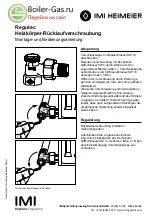
E93.1601EN032.C VGH installation manual
115
The condensate trap must
always be filled to the edge
with water, before replacing
to the unit.
Fan
When the fan blades are polluted and dirty, carefully clean the blades with a soft brush. Notice: do not use too
much force on the blades or else the fan might be out of balance and run irregularly, causing noises and fan
failures. Check the fan also for any water damages. In doubt always replace the fan of the boiler.
Condensate trap
Disassemble the condensate trap and clean every part of it. Check the condensate trap connection of the heat
exchanger for any blocking or pollution and clean it (if necessary). Check the functioning of the condensate trap
by pouring clean tap water in the boiler combustion chamber (when burner door is removed). This water will exit
the heat exchanger by the condensate trap. Notice: don’t wet the rear wall insulation.
When mounting the bottom part of the condensate trap, before commissioning the boiler
and/or after maintenance, the condensate trap must
ALWAYS
be completely filled with
water.
This is a safety measure: the water in the condensate trap keeps the flue gases
from leaking out of the heat exchanger via the condensate drain.
Heat exchanger and boiler combustion chamber
After the removal of the complete burner unit check if there is any debris and dirt in the heat exchanger. The coils
of the heat exchanger can be cleaned by using a
non-metallic
brush. After this the dirt and dust can be removed
with a vacuum cleaner and by flushing the boiler combustion chamber with water. Never expose the refractory
insulation in the back of the combustion chamber to water or get it wet. Don’t forget afterwards to clean the
condensate trap once again.
Gas/air ratio
With every service check and/or maintenance of the boiler always check the gas/air ratio by measuring the CO
2
percentage (flue gas) at the maximum and minimum load of the boiler. If necessary, adjust these values. See for
information chapter “Adjusting and setting the boiler” chapter 18.
Circulator (supplied separated from the boiler)
Check the electrical parts and the motor of the circulator for a correct functioning. The circulator must generate a
sufficient water flow over the (heat exchanger of) the boiler. When the circulator produces noise, is operational for
more than five years or has signs of water leakage it is recommended to replace the circulator as a precaution.
When faults and abnormalities are found by the service technician during service and
maintenance and these are not repairable, this information must be reported to the owner/end-
user of the installation. Also the owner/end-user must be advised how to fix these faults and
these faults must be reported in the service report / log file of the boiler.
During service and maintenance, the gas, supply air, flue gas and condensate connections are
disconnected, checked and replaced. Make sure that all these components are mounted
correctly before commissioning the boiler again.
Cleaning the combustion chamber and heat exchanger with acid or alkali products is prohibited.
Picture 19.15
Summary of Contents for VGH-299-CH
Page 6: ...E93 1601EN032 C VGH installation manual 6 1 SAFETY GUIDELINES ...
Page 59: ...E93 1601EN032 C VGH installation manual 59 Ladder Logic Diagram Figure 11 3 ...
Page 60: ...E93 1601EN032 C VGH installation manual 60 Electrical schematics Figure 11 4 ...
Page 61: ...E93 1601EN032 C VGH installation manual 61 Figure 11 5 ...
Page 123: ...E93 1601EN032 C VGH installation manual 123 22 SPARE PARTS Figure 22 1 ...
Page 124: ...E93 1601EN032 C VGH installation manual 124 Figure 22 2 ...
Page 127: ...E93 1601EN032 C VGH installation manual 127 ...














































